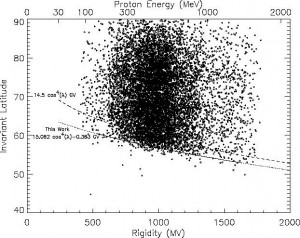A Measurement of the Quiet-Time Geomagnetic Cutoff for Cosmic Rays at Space Station Latitudes
Over most of the Space Station orbit, the astronauts are protected from exposure to low-energy cosmic rays and solar energetic particles by the Earth’s magnetic field. One way to express this shielding effect is with the so-called “geomagnetic cutoff”, by determining the minimum rigidity (or energy) particle that can penetrate to a given latitude. Most of our knowledge of the geomagnetic cutoff is due to simulations that trace particles through a geomagnetic field model. In a 1994 paper, Smart and Shea suggested that the simple relation Rc =3D 14.5cos^4 (Lambda) GV gives a good estimate of the geomagnetic cutoff in the zenith direction. In this relation Rc is the geomagnetic cutoff rigidity (in gigavolts), and Lambda is the “invariant latitude”, related to the McIlwain L-parameter by L =3D 1/cos^2 (Lambda). In other words, Rc =3D 14.5/(Lambda)^2 GV.
We have recently carried out a direct measurement of the quiet-time geomagnetic cutoff using individual cosmic ray nuclei detected by SAMPEX. The MAST instrument measures the nuclear charge, mass, and kinetic energy of individual cosmic rays with energies from ~20 to ~200 MeV/nucleon. From these data and the satellite location each particle’s rigidity (momentum/charge) and invariant latitude can be calculated, assuming that galactic cosmic rays are fully stripped of their electrons (anomalous cosmic rays, which may be singly-charged, were not included in this study). The accompanying figure (http://sampex.umd.edu/docs/ogliore1100.jpg) plots the measured invariant latitude and rigidity values for 10,102 cosmic rays with 5 < Z < 28 accumulated during solar and geomagnetically quiet periods from 7/92 to 2/95. Using these data, cutoff values were determined in nineteen rigidity intervals. An excellent fit to our measured cutoffs is given by Rc =3D 15.062cos^4 (Lambda) - 0.363 GV, which is plotted in the Figure below along with the earlier relation. These results show that at a given latitude the actual geomagnetic cutoff is systematically lower than is given by the Smart and Shea relation. One consequence of this new result is that cosmic rays and solar energetic particles can reach the Space Station over a significantly greater portion of its orbit than would have been expected. The ISS orbit covers invariant latitudes from 0 deg. to 66 deg. For galactic cosmic rays, the radiation exposure increases by about 17% for protons >30 MeV due to this new cutoff. In solar particle events, the effect of the lower cutoff is greatly enhanced due to the steeply falling energy spectra. As an example, for the solar proton spectrum measured during the recent Bastille Day event, we found that the average intensity of >100 MeV protons at the ISS would be ~4 times as great with this new relation. Extrapolating the new cutoff relation to somewhat lower rigidities we found the expected radiation level due to >30 MeV protons (typical energy to penetrate the Space Station) was ~20 times as great. Such an extrapolation is consistent with recent measurements of the geomagnetic cutoff during other large solar particle events. This increase of the exposure due to the lower quiet time cutoff assumes that the cutoff remains fixed during the solar particle event. If a CME/shock impacts the magnetosphere and reduces the cutoff even further, as is often the case in large solar particle events, then there will be additional exposure to the interplanetary radiation.
Figure Caption: Measured invariant latitude versus rigidity for 10,102 individual cosmic ray nuclei. Note that cosmic rays can reach latitudes several degrees below the commonly used relation Rc =3D 14.5cos^4 (Lambda) GV. The proposed new relation, Rc =3D 15.062cos^4 (Lambda) – 0.363 GV, provides a better estimate of the geomagnetic cutoff.
Contributed by Ryan Ogliore and Richard Mewaldt of Caltech
«Return to the Results page
